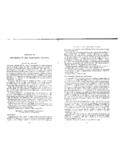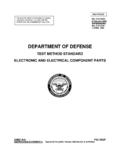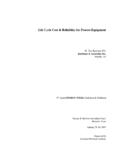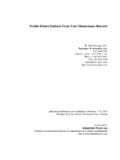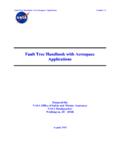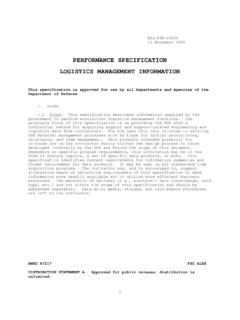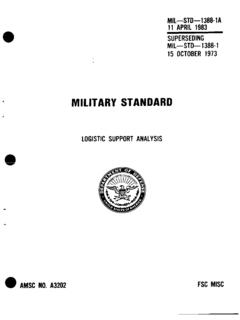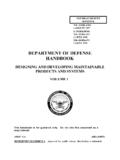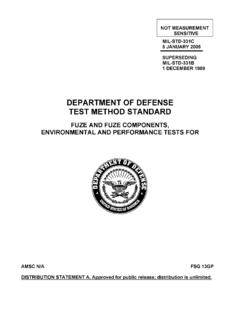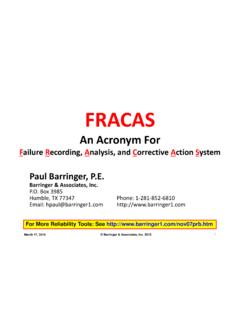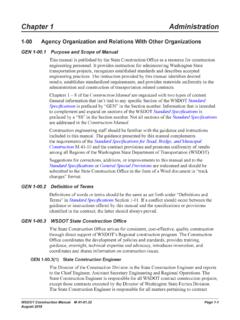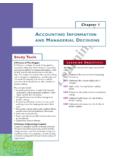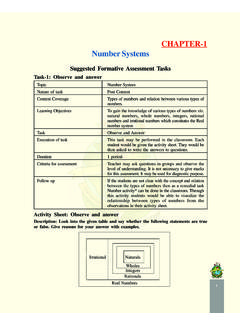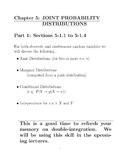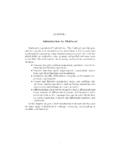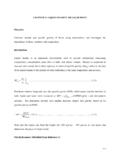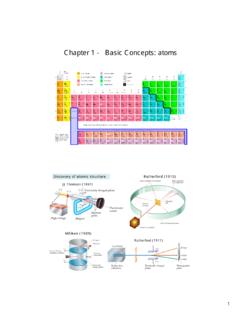Transcription of 00.BB 1. Chapter 1 0308 - Barringer1.com
1 Chapter 1: An Overview of Weibull Analysis 1-1. Chapter 1. AN OVERVIEW OF WEIBULL. ANALYSIS. Objective This handbook will provide an understanding of life data analysis. Weibull and Log Normal analysis will be emphasized particularly for failure analysis. There are new applications of this technology in medical and dental implants, warranty analysis, life cycle cost, materials properties and production process control. Related quantitative models such as the binomial, Poisson, Kaplan-Meier, Gumbel extreme value and the Crow-AMSAA are included. The author intends that a novice engineer can perform Weibull analysis after studying this document. A secondary objective is to show the application of personal computers to replace the laborious hand calculations and manual plotting required in the past. Background Waloddi Weibull invented the Weibull distribution in 1937 and delivered his hallmark American paper on this subject in 1951.
2 He claimed that his distribution applied to a wide range of problems. He illustrated this point with seven examples ranging from the strength of steel to the height of adult males in the British Isles. He claimed that the function " may sometimes render good service." He did not claim that it always worked. Time has shown that Waloddi Weibull was correct in both of these statements. His biography is in Appendix N. The reaction to his paper in the 1950s was negative, varying from skepticism to outright rejection. The author was one of the skeptics. Weibull's claim that the data could select the distribution and fit the parameters seemed too good to be true. However, pioneers in the field like Dorian Shainin and Leonard Johnson applied and improved the technique. The Air Force recognized the merit of Weibull's method and funded his research until 1975. Today, Weibull analysis is the leading method in the world for fitting and analyzing life data.
3 Dorian Shainin introduced the author to statistical engineering at the Hartford Graduate Center (RPI) in the mid-fifties. He strongly encouraged the author and Pratt &. Whitney Aircraft to use Weibull analysis. He wrote the first booklet on Weibull analysis and produced a movie on the subject for Pratt & Whitney Aircraft. Leonard Johnson at General Motors improved on Weibull's plotting methods. Weibull used mean ranks for plotting positions. Johnson suggested the use of median ranks which are slightly more accurate than mean ranks. Johnson also pioneered the use of the Beta-Binomial confidence bounds described in Chapter 7. Gumbel showed that the Weibull distribution and the Type III Smallest Extreme Values distributions are the same. He also proved that if a part has multiple failure modes, the time to first failure is best modeled by the Weibull Waloddi Weibull 1887-1979. distribution. This is the "weakest-link-in-the-chain" concept.
4 Photo by Sam C. Saunders See page 1-12 for more on Dorian Shainin and Gumbel. Dr. Robert B. Abernethy 536 Oyster Road, North Palm Beach, FL 33408-4328 561-842-4082. 1-2 The New Weibull Handbook The author found that the Weibull method works with extremely small samples, even two or three failures for engineering analysis. This characteristic is important with aerospace safety problems and in development testing with small samples. (For statistical relevance, larger samples are needed.) Advanced techniques such as failure forecasting, substantiation of test designs, and methods like Weibayes and the Dauser Shift were developed by the author and others at Pratt & Whitney. (In retrospect, others also independently invented some of these techniques like Weibayes in the same time period.) Such methods overcome many deficiencies in the data. These advanced methods and others are presented in this Handbook. Examples The following are examples of engineering problems solved with Weibull analysis: A project engineer reports three failures of a component in service operations during a three-month period.
5 The Program Manager asks, "How many failures will we have in the next quarter, six months, and year?" What will it cost? What is the best corrective action to reduce the risk and losses? To order spare parts and schedule maintenance labor, how many units will be returned to depot for overhaul for each failure mode month-by-month next year? The program manager wants to be 95%. confident that he will have enough spare parts and labor available to support the overall program. A state Air Resources Board requires a fleet recall when any part in the emissions system exceeds a 4% failure rate during the warranty period. Based on the warranty data, which parts will exceed the 4% rate and on what date? After an engineering change, how many units must be tested for how long, without any failures, to verify that the old failure mode is eliminated, or significantly improved with 90% confidence? An electric utility is plagued with outages from superheater tube failures.
6 Based on inspection data forecast the life of the boiler based on plugging failed tubes. The boiler is replaced when 10% of the tubes have been plugged due to failure. The cost of an unplanned failure for a component, subject to a wear out failure mode, is twenty times the cost of a planned replacement. What is the optimal replacement interval? Scope Weibull analysis includes: Plotting the data and interpreting the plot Warranty analysis and support cost Failure forecasting and prediction predictions Evaluating corrective action plans Controlling production processes Test substantiation for new designs with Calibration of complex design systems, minimum cost , CAD\CAM, finite analysis, etc. Maintenance planning and cost effective Recommendations to management in replacement strategies response to service problems Spare parts forecasting Data problems and deficiencies include: Censored or suspended data No failure data Mixtures of failure modes Early data missing Nonzero time origin Inspection data, both interval and probit Unknown ages for successful units Extremely small samples (as small as one failure).
7 Dr. Robert B. Abernethy 536 Oyster Road, North Palm Beach, FL 33408-4328 561-842-4082. Chapter 1: An Overview of Weibull Analysis 1-3. Failure types include: Development, production and service Mechanical, electronic, materials, and human failures Nature: lightning strikes, foreign object damage, human error, woodpecker holes in power poles Quality control, design deficiencies, defective material Warranty claims Math modeling for system analysis includes: Explicit models for independent failure modes Monte Carlo simulation for dependent failure modes. Reliability growth, repairability, and management tracking using Crow-AMSAA models Exponential, binomial and Poisson models Kaplan-Meier Survivor Models Warranty Claims models Production Process Control Models Statistical derivations are in the Appendices to keep the main body of the Handbook more readable. The author leans toward simple methods as being most useful and easily understood.
8 Complex methods that require sophisticated mathematics are academically interesting, but they are difficult to communicate and explain. Engineers are reluctant to use methods they do not understand. However, many of these complex methods such as confidence intervals are included, as the student may be required to employ them. Qualitative reliability methods are not included such as failure mode and effects analysis, failure analysis, and fault trees. These are important and recommended, but they are not described herein as the emphasis is on quantitative methods. See [O'Connor] for treatment of qualitative methods. Advantages of Weibull Analysis The primary advantage of Weibull analysis is the ability to provide reasonably accurate failure analysis and failure forecasts with extremely small samples. Solutions are possible at the earliest indications of a problem without having to "crash a few more." Small samples also allow cost effective component testing.
9 For example, "sudden death" Weibull tests are completed when the first failure occurs in each group of components, (say, groups of four bearings). If all the bearings are tested to failure, the cost and time required is much greater. Another advantage of Weibull analysis is that it provides a simple and useful graphical plot of the failure data. The data plot is extremely important to the engineer and to the manager. The Weibull data plot is particularly informative as Weibull pointed out in his 1951 paper. Figure 1-1 is a typical Weibull plot. The horizontal scale is a measure of life or aging. Start/stop cycles, mileage, operating time, landings or mission cycles are examples of aging parameters. The vertical scale is the cumulative percentage failed. The two defining parameters of the Weibull line are the slope, beta, and the characteristic life, eta. The slope of the line, , is particularly significant and may provide a clue to the physics of the failure.
10 The relationship between the slope and generic failure classes is discussed in Section and Chapter 2. The characteristic life, , is the typical time to failure in Weibull analysis. It is related to the mean time to failure. Data, Discrete Versus Life Data Discrete or counted data was originally used to measure reliability. Tests would be categorized as success or failure. Receiving inspection data would count good parts versus defective parts. This data is modeled with the binomial and Poisson distributions described in Chapter 8. The results are imprecise unless enormous sample sizes are employed. The author has developed a new method using the Crow-AMSAA. model that is much more precise and accurate for success-failure and go-no go data when the sample size is large. (See Chapter 9.). Dr. Robert B. Abernethy 536 Oyster Road, North Palm Beach, FL 33408-4328 561-842-4082. 1-4 The New Weibull Handbook Measured data like age-to-failure data is much more precise because there is more information in each data point.
